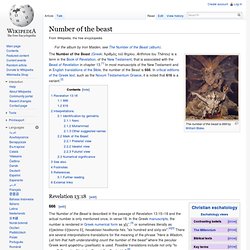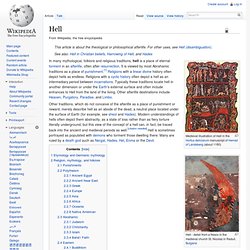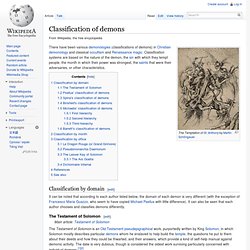

Who Are The Nephilim AKA Anunaki AKA Watchers (And What Do They Have To Do With St. Valentine's)? - Occult Center.Com. Every now and then some movie or TV series makes a reference to the Nephilim.

Reptilian conspiracy theories also reference the Anunaki. Today, on St. Valentine's day I thought would be the best occasion to make a post explaining quickly all about Nephilim, Nephlim, Anakim, Anunaki and what do they all have to do with the St. Valentine's day. Hebrew Torah mentions "Nephilim" twice (Genesis 6.1 and Numbers 13:33). This ancient book is referred to in "Sepher Zohar", it is mentioned by apostle Jude, and in Koran (Sura 28,20). The Love Story In this book Enoch, son of Jared, speaks about the angels called "Watchers" appointed to protect human kind. All of them fell in love with different human women and decided to abandon haven so they could live with them. Devil. The Devil (from Greek: διάβολος or diábolos = slanderer or accuser)[1] is believed in many religions, myths and cultures to be a supernatural entity that is the personification of evil and the enemy of God and humankind.

The nature of the role varies greatly, ranging from being an effective opposite force to the creator god, locked in an eons long struggle for human souls on what may seem even terms (to the point of dualistic ditheism/bitheism), to being a comical figure of fun or an abstract aspect of the individual human condition. While mainstream Judaism contains no overt concept of a devil, Christianity and Islam have variously regarded the Devil as a rebellious fallen angel that tempts humans to sin, if not commit evil deeds himself. In these religions – particularly during periods of division or external threat – the Devil has assumed more of a dualistic status commonly associated with heretics, infidels, and other unbelievers.
Etymology Abrahamic religions Judaism Christianity Islam. Dictionnaire Infernal. The Dictionnaire Infernal (English: Infernal Dictionary) is a book on demonology, organised in hellish hierarchies.

It was written by Jacques Auguste Simon Collin de Plancy and first published in 1818. There were several editions of the book; perhaps the most famous is the 1863 edition, which included sixty-nine illustrations by Louis Le Breton depicting the appearances of several of the demons. Many but not all of these images were later used in S. L. Pseudomonarchia Daemonum.
Number of the Beast. Revelation 13:18[edit] 666[edit] The Number of the Beast is described in the passage of Revelation 13:15–18 and the actual number is only mentioned once, in verse 18.

In the Greek manuscripts, the number is rendered in Greek numerical form as χξϛʹ,[3] or sometimes literally as ἑξακόσιοι ἑξήκοντα ἕξ, hexakósioi hexēkonta héx, "six hundred and sixty-six".[4][5] There are several interpretations-translations for the meaning of the phrase "Here is Wisdom, Let him that hath understanding count the number of the beast" where the peculiar Greek word ψηφισάτω (psefisato) is used. Possible translations include not only "to count", "to reckon" but also "to vote" or "to decide".[6] Classification of demons. There have been various demonologies (classifications of demons) in Christian demonology and classical occultism and Renaissance magic.

Classification systems are based on the nature of the demon, the sin with which they tempt people, the month in which their power was strongest, the saints that were their adversaries, or other characteristics. Classification by domain[edit] It can be noted that according to each author listed below, the domain of each demon is very different (with the exception of Francesco Maria Guazzo, who seem to have copied Michael Psellus with little difference). It can also be seen that each author chooses and classifies demons differently. Hell. Hell - detail from a fresco in the medieval church St.

Nicolas in Raduil, Bulgaria In many mythological, folklore and religious traditions, hell is a place of eternal torment in an afterlife, often after resurrection. It is viewed by most Abrahamic traditions as a place of punishment.[1] Religions with a linear divine history often depict hells as endless. Religions with a cyclic history often depict a hell as an intermediary period between incarnations. Typically these traditions locate hell in another dimension or under the Earth's external surface and often include entrances to Hell from the land of the living. Etymology and Germanic mythology Religion, mythology, and folklore Hell appears in several mythologies and religions.
Punishments Punishment in Hell typically corresponds to sins committed during life. Theistic Satanism. Buer (demon) Classification of demons. There have been various demonologies (classifications of demons) in Christian demonology and classical occultism and Renaissance magic.

Classification systems are based on the nature of the demon, the sin with which they tempt people, the month in which their power was strongest, the saints that were their adversaries, or other characteristics. Classification by domain[edit] It can be noted that according to each author listed below, the domain of each demon is very different (with the exception of Francesco Maria Guazzo, who seem to have copied Michael Psellus with little difference). It can also be seen that each author chooses and classifies demons differently. The Lesser Key of Solomon. The Lesser Key of Solomon, also known as Clavicula Salomonis Regis[note 1] or Lemegeton, is an anonymous grimoire (or spell book) on demonology.

It was compiled in the mid-17th century, mostly from materials a couple of centuries older.[1][2] It is divided into five books—the Ars Goetia, Ars Theurgia-Goetia, Ars Paulina, Ars Almadel, and Ars Notoria.[1][3] Ars Goetia[edit] The most obvious source for the Ars Goetia is Johann Weyer's Pseudomonarchia Daemonum in his De praestigiis daemonum.